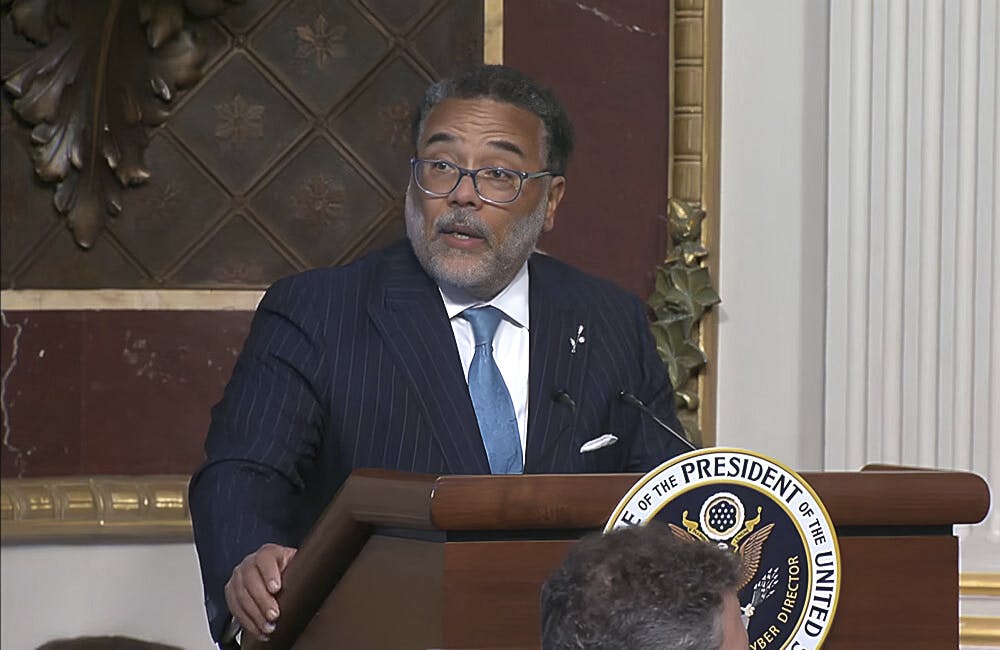DHS Sees AI as Key for Fighting Drug, Border Crimes
Agency leadership say the tool is helping fight serious crime more quickly and accurately.

The Department of Homeland Security (DHS) is prioritizing artificial intelligence development to enhance missions fighting the illegal drug trade and investigating crime.
“We consider there to be tremendous promise in the use of AI to advance our mission,” said DHS Secretary Alejandro Mayorkas at an Axios event in Washington, D.C., Tuesday.
Mayorkas cited AI already helping in the fight against fentanyl along the border. It is “using AI to detect unusual travel patterns of vehicles crossing the border,” he said. “In 1.4 seconds, we identified an anomaly of a particular truck that ended up having about 75 kilograms of narcotics in it.”
AI also is enabling the agency to detect foreign objects and issue real-time alerts when detecting anomalies, he added.
Earlier this year DHS established the Center for Accelerating Operational Efficiency (CAOE) headed by Arizona State University to further research and enhance AI tools for border operations.
“We have a responsibility to facilitate lawful trade and travel, there’s a tremendous amount of legal trade and travel coming through our ports of entry. And so the faster that we can make decisions, the faster we can identify anomalies,” Mayorkas said.
In August, Homeland Security Investigations (HSI) completed Operation Renewed Hope targeting online child sexual abuse. The team used AI and machine-learning models to enhance old images and identify over 300 victims who were previously unknown.
“We engage the machine in engaged regression analysis so that they can actually develop for us an image of the child X number of years later since the abduction,” Mayorkas said. “We’ve actually recovered children, victims of abduction and exploitation through that age-progression methodology.”
The operation was a first of its kind and showed promise for the technology in future cases.
“Our HSI workforce is deeply committed to identifying, locating and rescuing victims being abused and apprehending those who prey on the vulnerable. On this we cannot be more clear: If you are abusing or exploiting children, we will leverage every authority, partnership and resource at our disposal to bring you to justice,” said HSI Executive Associate Director Katrina Berger in an Aug. 9 press release.
DHS emphasizes speed as a top attribute for using AI, given the time-consuming nature of information analysis.
“The ability to take all the reports of interviews, the thousands of reports of interviews, identify patterns and make connections where now the labor wouldn’t be so extraordinarily intensive,” Mayorkas said. “Through AI, we can do that in a matter of seconds and really assist an investigator in identifying a connectivity that previously we would not have been aware of.”
While the agency sees continued promise for using AI to advance its mission, it is putting in place efforts to meet the White House executive order directing agencies to develop responsible and trustworthy AI.
“In my discussions with companies that are in the business of the development of AI and its advancement, I have certainly seen just quite immediately, a social consciousness, an understanding of its potential to do great, an understanding of the risks involved, and a very significant desire to advance one and to manage the other,” Mayorkas said.
This is a carousel with manually rotating slides. Use Next and Previous buttons to navigate or jump to a slide with the slide dots
-

State Department Touts Digital Diplomacy in New Tech Strategy
The new plan outlines ‘digital solidarity’ to counter threats in cyberspace, including malicious artificial intelligence.
8m read -

DHS, DOD Officials: AI is a Teammate, Not a Tool
AI can work alongside government by providing better information to humans for them to make real-time decisions.
5m read -

White House Might Remove Degrees From Federal Cyber, IT Jobs
White House and federal leaders are moving toward skills-based hiring practices to fill critical roles in IT and cybersecurity.
5m read -

Federal Agencies Make the Case for Quantum
Amid development of emerging technologies like AI and machine learning, leaders see promise in quantum computing.
6m read








